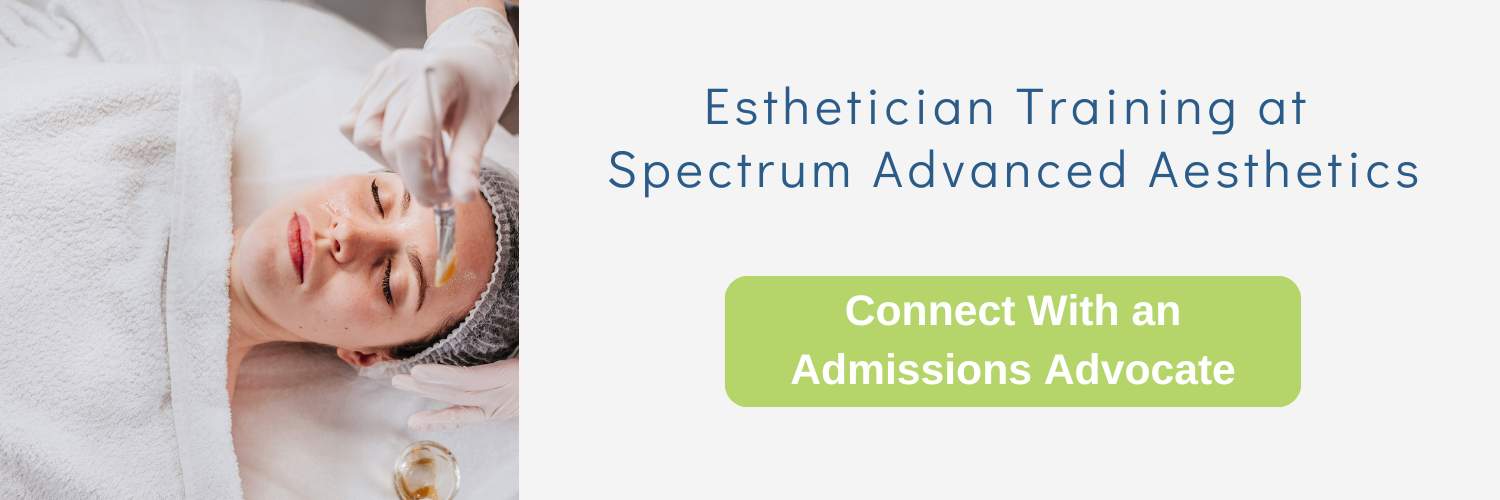Face-Off: The Difference Between a Dermatologist vs. an Esthetician and How To Decide Which Path Is Right for You

Spectrum Advanced Aesthetics is the premier esthetics school in the Pacific Northwest, so we know a thing or two about careers in skincare. Whether you are just starting your professional journey or seeking a midlife career change, it's essential to consider all your options.
So, what is the difference between dermatology and esthetician career paths?
Both dermatologists and estheticians work with skin care and health, but they vary greatly in the education and training time required. Read on to learn more about which new career may be right for you.
Table of Contents
- What Is a Dermatologist?
- What Is an Esthetician?
- Commonly Asked Questions About Dermatologist vs. Esthetician
- What’s the Difference Between a Cosmetic Dermatologist and an Esthetician?
- Dermatologist vs. Esthetician: How Do I Know Which Career Path Is Right for Me?
- Spectrum Advanced Aesthetics: Oregon’s Top Licensed Esthetician School Offering Flexible Full-Time & Hybrid Programs
What is a dermatologist, and what do they do?
According to the American Academy of Dermatology, “dermatologists are highly skilled and trained medical doctors and skin surgeons who specialize in the largest organ in the body, the skin!”
Dermatology is not a career path taken lightly, as it requires both an undergraduate degree and a medical school degree, as well as several years of specialized training. We will discuss this more later, but for now, just know that becoming a dermatologist is an undertaking similar to becoming a pediatrician or surgeon.
What Services Can a Dermatologist Perform?
Dermatologists are licensed doctors who are trained to identify, diagnose, and treat skin conditions ranging from severe (such as melanoma) to minor (such as wrinkles) and everything in between. Here are a few examples of the skin conditions dermatologists treat:
- Severe, cystic, or nodular acne
- Keloid scarring
- Eczema and other atopic dermatitis
- Melanoma and other skin cancers
- Psoriasis
This list is far from comprehensive, as skin diseases and disorders are complex and varied. As medical doctors, dermatologists are licensed to diagnose these conditions and prescribe treatments.
Dermatologists also provide cosmetic skin care and treatments, such as Botox, fillers, chemical peels, and certain laser treatments.
How Do You Become a Licensed Dermatologist?
If you want to become a licensed dermatologist, prepare for a long educational and training journey. To practice as a dermatologist, you must do the following:
- Complete a bachelor's degree from a college or university. Most medical schools require specific majors, such as biology, chemistry, physics, or anatomy.
- Pass the MCAT (Medical College Admissions Test).
- Get accepted into and complete medical school. During this time, you would specify your studies in dermatology. It is important to note that dermatology is currently ranked as the most competitive medical specialty for students, so if you struggle in medical school, you may have a hard time getting a dermatology internship and/or residency.
- Complete both an internship and medical residency. Internships are the first part, where future dermatologists see patients under supervision at hospitals and medical clinics. Internships are then followed by a highly competitive dermatology residency program. This program is 2-3 years long and involves research and publishing papers as well as seeing patients.
- After completing these steps, you are technically allowed to practice as a dermatologist. However, the majority of dermatologists go on to become board-certified and complete a dermatology fellowship. This gives them more training and a competitive edge in the market.
This whole process can take 10-12 years, often longer. As with most medical professionals, the training and education in dermatology never truly ends as medicine continues to grow and evolve. So if you are thinking about becoming a dermatologist, consider how much you like education and being in school.
Estheticians are skin-care professionals licensed by the state. Estheticians provide a variety of skincare treatments and procedures that focus on enhancing the health and appearance of skin.
Medical Aestheticians vs. Spa Estheticians
You may have heard the term “medical aesthetician” before. What does it mean, and what is the difference between a medical aesthetician and a spa esthetician?
According to Spectrum Advanced Aesthetics, the premier aesthetics school in the PNW, a medical aesthetician can perform certain advanced procedures. These procedures are less invasive than plastic surgery, but are more intensive than routine beauty treatments. Examples include laser hair removal, body contouring, and RF microneedling. Medical aesthetician is not a legally recognized title, however. In Oregon, an esthetician with the training to perform laser hair removal, body contouring and RF microneedling is legally called a Certified Advanced Esthetician.
Spa estheticians tend to work more with routine beauty treatments, such as reflexology, aromatherapy, facials, waxing, body wraps, etc. Both medical aestheticians and spa estheticians focus on skin health and wellness.

What Services Can an Esthetician Perform?
An esthetician is a state-certified skincare expert. Basic esthetician services include:
- Facials
- Extractions of blackheads or pore buildup
- Microdermabrasion
- Airbrush tanning
- Professional makeup application
- Brow and body waxing
- Body wraps and scrubs
- And more
Esthetics is a constantly changing and evolving field, so this list is not comprehensive. However, some treatments, such as dermaplaning, chemical peels,and certain facials require additional education, certification, and licensing.
To learn more about advanced aesthetic techniques and how they work, check out Spectrum Advanced Aesthetics programs. As the top aesthetics school in the PNW, Spectrum has classes and training for all the newest and most in-demand procedures.
.jpg)
How Do You Become a Licensed Esthetician?
Are you ready to start your esthetician journey? A standard esthetician’s training journey requires:
- A high school diploma or GED equivalent
- Enrollment and completion of an esthetician program from an accredited esthetician school. Training time varies by program, but usually lasts between 200 and 1000 hours. Some schools, like Spectrum Advanced Aesthetics, offer convenient online and in-person hybrid class options.
- Hands-on training where students practice procedures under the supervision of licensed esthetician instructors.
- Passing the state esthetician licensing exam
After passing the state licensing exam, you are technically able to practice as an esthetician.
However, most estheticians choose to continue their education with an advanced aesthetician degree to gain an edge in a competitive job market.
There are a lot of differences between cosmetic dermatologists and estheticians, specifically the type of skin care involved and the length of training.
A cosmetic dermatologist is a medical doctor who specializes in all aspects of the skin and can diagnose, as well as treat, a variety of skin disorders. They can also provide medically delicate procedures such as Botox and filler injections.
Estheticians are skincare professionals, focused on improving skin health and overall appearance through non-invasive or minimally invasive techniques. While a cosmetic dermatologist works with all aspects of the skin, estheticians tend to focus on improving the upper layers of skin.
Is It Better To Go to a Dermatologist Or an Esthetician?
Should you see a dermatologist or an esthetician? Well, that depends on your skin concerns. For certain medical skin problems such as rashes, suspicious moles, or lesions, a dermatologist is your first stop. If you want to improve overall skin appearance and texture, then an esthetician is your best bet.
Not sure which to see? Start with a dermatologist to ensure nothing dangerous is going on and go from there.
Do Estheticians or Dermatologists Make More Money?
Esthetician vs. dermatologist salary — who makes more money? As a doctor in a highly competitive medical field, dermatologists make more money than estheticians. However, they have to complete over a decade of specialized schooling and training, usually taking out many student loans to do so.
Estheticians make less money than dermatologists, but can still make a comfortable living. They also require much less schooling, allowing you to start working and earning faster.

Can Estheticians and Dermatologists Both Diagnose Medical Skin Conditions?
No. Only dermatologists can diagnose skin conditions, as well as prescribe medication or surgical treatment. For any suspicious rashes, moles, or lesions, it is important to seek the opinion of a dermatologist.
Esthetician vs. Dermatologist: Who Should I See for Acne?
Whether you should see an esthetician or dermatologist for acne depends on what kind of acne you have.
For mild to moderate acne and hormonal breakouts, estheticians can provide some relief with extractions and facials, as well as skincare regimens to support healthy skin.
However, an esthetician cannot diagnose or treat skin conditions such as severe nodular or cystic acne. For those conditions, an esthetician would recommend treatment by a dermatologist.
Can Dermatologists and Estheticians Complement Each Other’s Services?
Yes! Many advanced aestheticians and estheticians with nutritional support certification work in dermatology practices alongside dermatologists. This allows patients to get a medical diagnosis and care for their skin, alongside aesthetician practices to provide holistic, effective, and sustainable skincare.

Only you know what career path best suits you. Both dermatologist and esthetician career paths involve skincare, but they vary in education, training, and overall goals. Ask yourself what your ultimate goal is, how much education and training you want to undertake, and what kind of salary you are hoping to achieve.
If you have a passion for medical skincare and a desire to pursue a competitive career in health and medicine, take the time to look into starting your career in dermatology.
On the other hand, if you are looking to help people improve their skin’s health and appearance, as well as make them feel like their best selves through waxing and makeup application, then a career as an esthetician may be right for you. However, not all aesthetician schools are created equal, and you need a quality education to enter the competitive field of esthetics.
If you are considering a career in aesthetics, check out Spectrum Advanced Aesthetics, the PNW’s best aesthetic school.
Spectrum Advanced Aesthetics is more than just a school. Our programs are designed to give students the real-world training they need from working professionals who know the industry best.
With cutting-edge programs and a variety of continued learning and certification options, Spectrum Advanced Aesthetics sets its students up for success. We also offer hybrid courses and financing options that allow our students to learn in ways that best support them. Check out our website to learn more about all the doors Spectrum Advanced Aesthetics can open for you.



.svg)
.svg)